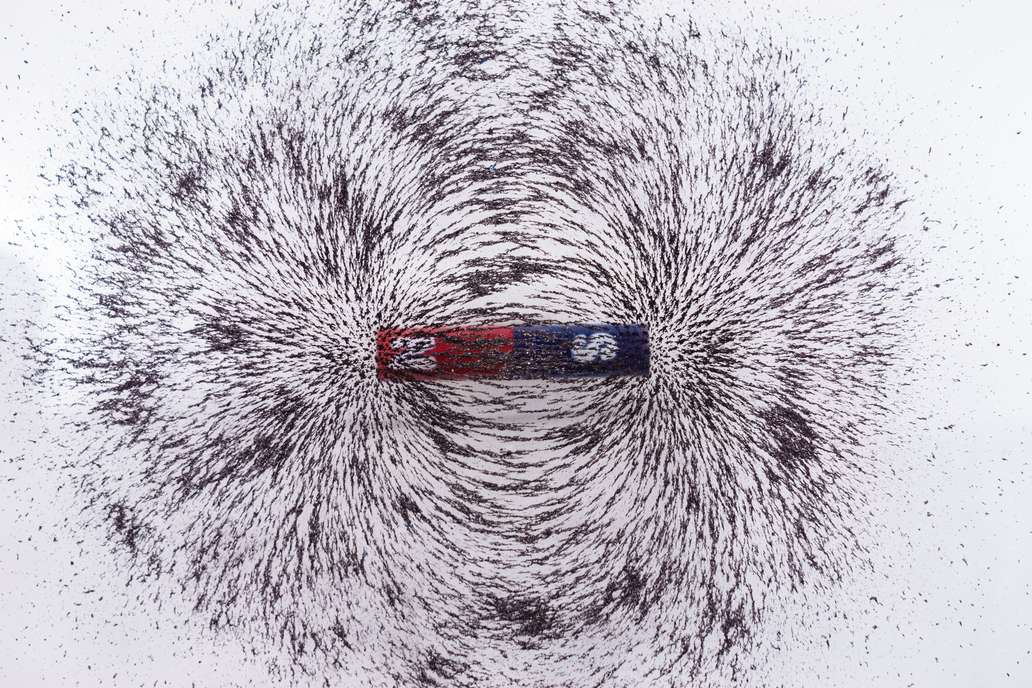Magnetism
Magnetism has been known to mankind for thousands of years. Already the ancient Greeks reported 2,000 years ago of a stone called Magnes, which could miraculously attract objects made of iron.

The mystery of the magic stone from ancient times has been solved in the meantime. The Greeks had discovered the iron ore Magnetite.
Today's name is derived from the word Magnes. Magnetite, along with hematite, is one of the most frequently smelted iron ores and already has magnetic properties in its natural state.
Magnetic is a colloquial term. It refers to ferromagnetism, a form of magnetism with which most people are familiar. In total, there are only three metals that have ferromagnetic properties. These are iron, cobalt and nickel, which have magnetic domains that allow them to be magnetised.
Magnetic domains
The magnetic domains of the ferromagnetic elements are also called "Weiss Domains". Each of these domains is microscopically small and has a homogeneous magnetic orientation inside. The picture on the left shows schematically how the domains align themselves to an external magnetic field.
On its own, each individual domain would be magnetic. However, the neighboring domains are aligned differently, so the magnetic properties weaken or cancel each other out.
When ferromagnetic materials are exposed to a magnetic field, all domains in the metal structure align themselves in the same way. This causes the material itself to become magnetized. If the metal is removed from the magnetic field, the magnetization is retained for a while. This effect fades away with most types of steel. In hardened steel, however, the magnetization is retained.
Magnetic fields
Magnets, magnetized objects and electromagnets (coils) generate fields that transmit forces. The magnetic field is characterized by field lines that run from the north to the south pole of the magnet. Depending on their orientation, these magnetic fields either attract or repel each other. These properties can be used technically.
Our modern world cannot dispense with magnets. They can be found in televisions, mobile phones, in measuring instruments, are used in medicine and are elementary components in mechanical engineering. In this field, electric motors, transformers, brake systems and magnetic bearings are just a few examples from industry.
Why are some types of steel magnetic and some not?
The two most common misconceptions
The purity of the alloy
Even a low concentration of steel-associated elements such as sulphur or phosphorus would be enough to prevent magnetizability. This is wrong! These elements have no influence on the magnetic properties. For quality reasons, they are kept very low in rustproof steel because they embrittle the material.
Stainless steel is non-magnetic
There is a persistent rumour that stainless steel is not magnetic. However, this is not always the case. There are magnetic types of stainless steel! Whether this steel is stainless or not depends on the chromium content and this does not affect the magnetic properties of the material in any way.
The real reason
The magnetic nature of a steel grade is solely a question of its microstructure. In our article on the iron-carbon diagram, the different types of microstructure are discussed in detail.
Steels that have a ferritic or martensitic microstructure are magnetic. Steel grades with an austenitic microstructure are non-magnetic. If a steel grade contains a mixed microstructure of ferrite and austenite, the proportion of ferrite determines the magnetic properties of the steel.
See also
Brinell hardness test
Performing the hardness test by means of a ball pressure test according to the Swedish engineer Johann August Brinell.
Read moreCoil
Plate metal that is rolled-up to coils is easier to transport and requires less space in the warehouse
Read moreCorrosion
Corrosion is a natural process and damages most metals. What types of corrosion are there?
Read more
